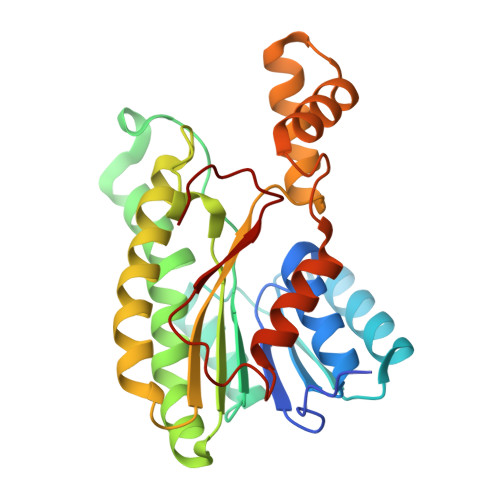Cautionary Tale of Using Tris(alkyl)phosphine Reducing Agents with NAD+-Dependent Enzymes.
Patel, S.M., Smith, T.G., Morton, M., Stiers, K.M., Seravalli, J., Mayclin, S.J., Edwards, T.E., Tanner, J.J., Becker, D.F.(2020) Biochemistry
- PubMed: 32841567
- DOI: https://doi.org/10.1021/acs.biochem.0c00490
- Primary Citation of Related Structures:
5VPS - PubMed Abstract:
Protein biochemistry protocols typically include disulfide bond reducing agents to guard against unwanted thiol oxidation and protein aggregation. Commonly used disulfide bond reducing agents include dithiothreitol, β-mercaptoethanol, glutathione, and the tris(alkyl)phosphine compounds tris(2-carboxyethyl)phosphine (TCEP) and tris(3-hydroxypropyl)phosphine (THPP). While studying the catalytic activity of the NAD(P)H-dependent enzyme Δ 1 -pyrroline-5-carboxylate reductase, we unexpectedly observed a rapid non-enzymatic chemical reaction between NAD + and the reducing agents TCEP and THPP. The product of the reaction exhibits a maximum ultraviolet absorbance peak at 334 nm and forms with an apparent association rate constant of 231-491 M -1 s -1 . The reaction is reversible, and nuclear magnetic resonance characterization ( 1 H, 13 C, and 31 P) of the product revealed a covalent adduct between the phosphorus of the tris(alkyl)phosphine reducing agent and the C4 atom of the nicotinamide ring of NAD + . We also report a 1.45 Å resolution crystal structure of short-chain dehydrogenase/reductase with the NADP + -TCEP reaction product bound in the cofactor binding site, which shows that the adduct can potentially inhibit enzymes. These findings serve to caution researchers when using TCEP or THPP in experimental protocols with NAD(P) + . Because NAD(P) + -dependent oxidoreductases are widespread in nature, our results may be broadly relevant.
Organizational Affiliation:
Department of Biochemistry, University of Missouri, Columbia, Missouri 65211, United States.
















